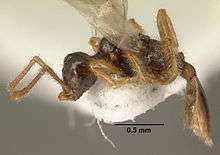Tetramorium inquilinum
Tetramorium inquilinum is an ectoparasitic ant found in Europe. It was discovered by Swiss myrmecologist Heinrich Kutter.[3] The species is unusual for lacking a worker caste, the queens and males living entirely off the care of the pavement ant.[4] It has been called "the 'ultimate' parasitic ant" by myrmecologists Edward O. Wilson and Bert Hölldobler.[5]
| Tetramorium inquilinum | |
|---|---|
 | |
| T. inquilinum alate queen from France | |
| Scientific classification | |
| Kingdom: | Animalia |
| Phylum: | Arthropoda |
| Class: | Insecta |
| Order: | Hymenoptera |
| Family: | Formicidae |
| Subfamily: | Myrmicinae |
| Genus: | Tetramorium |
| Species: | T. inquilinum |
| Binomial name | |
| Tetramorium inquilinum | |
| Synonyms | |
| |
Taxonomy
Kutter described the species in 1950, naming it Teleutomyrmex schneideri and designating it the type species of its newly-circumscribed genus. He named it after his teacher and friend Otto Schneider-Orelli. Kutter discovered the holotype himself; the species's type locality is Saas-Fee, Valais, Switzerland.[6] The genus name, "Teleutomyrmex", meant "last" or "final" ant.[5]
In a 2015 revision of the subfamily Myrmicinae, Philip S. Ward, Seán G. Brady, Brian L. Fisher, and Ted R. Schultz classified the genus Teleutomyrmex as a junior synonym of Tetramorium. They created a nomen novum for this species, T. inquilinum, due to the presence of a senior homonym: Tetramorium schneideri Emery, 1898;[7] Carlo Emery had named this species after a different individual, Oskar Schneider, who had collected the holotype.[8] Ward and colleagues' replacement specific epithet refers to the species's inquiline behavior (Latin: inquilīnus, lit. 'inhabitant, tenant'[9]). This synonymy is contested by some myrmecologists, on the basis of the monophyly of the Teleutomyrmex complex and its very specific biology.[10]
Distribution
This species has been found in the Swiss Alps,[6] the French Alps,[11][12] the French Pyrenees,[13] Spain,[14][15] and Turkmenistan.[16]
Morphology
The body shape of Tetramorium inquilinum is specifically adapted. The queens average 2.5 mm in length, and have a concave form and large pads and claws. Tetramorium inquilinum is frail and unable to care for itself, with mandibles too small and weak to handle anything but liquid food, sting and poison glands small, and glands that produce food for larvae and protection against bacteria are completely absent. Its exoskeleton is thin and its brain and central nerve cord are small and simplified.
Behavior
Tetramorium inquilinum constantly sends chemical signals that trick host ants into accepting them as full members of the colony. Being ectoparasitic, Tetramorium inquilinum spends most of its adult life clinging to the backs of its hosts, especially queens. As many as eight have been observed piggy-backing onto a single host queen, leaving her immobile.[3]
Diet
Tetramorium inquilinum lives entirely on food regurgitated by its hosts, even the liquid meant for the host queen.[3]
Reproduction
Nourished and nurtured well by its hosts, Tetramorium inquilinum has high fecundity. Older individuals lay an average of two eggs every minute.[3]
References
- Social Insects Specialist Group (1996). "Teleutomyrmex schneideri". IUCN Red List of Threatened Species. 1996: e.T21569A9301467.
- Bolton, B. (2017). "Tetramorium inquilinum Ward, Brady, Fisher & Schultz, 2015 valid". AntCat. Retrieved 3 October 2017.
- Hölldobler, Bert; Wilson, Edward O. (1994). Journey to the Ants: A Story of Scientific Exploration. Cambridge, Mass.: The Belknap Press of Harvard University Press. ISBN 9780674485266.
- Wilson, Edward O. (1963). "The Social Biology of Ants". Annual Review of Entomology. 8 (1): 360. doi:10.1146/annurev.en.08.010163.002021.
- Hölldobler, Bert, 1936- (1990). The ants. Wilson, Edward O. Cambridge, Mass.: Belknap Press of Harvard University Press. ISBN 0-674-04075-9. OCLC 19325464.CS1 maint: multiple names: authors list (link)
- Kutter, H. (1950). "Über eine neue, extrem parasitische Ameise. 1. Mitteilung". Mitteilungen der Schweizerischen Entomologischen Gesellschaft. 23 (2): 81–94. doi:10.5169/seals-401089.
- Ward, Philip S.; Brady, Seán G.; Fisher, Brian L.; Schultz, Ted R. (2015). "The evolution of myrmicine ants: phylogeny and biogeography of a hyperdiverse ant clade (Hymenoptera: Formicidae)". Systematic Entomology. 40 (1): 76. doi:10.1111/syen.12090.
- Emery, C. (1898). "Beiträge zur Kenntniss der palæarktischen Ameisen". Öfversigt Af Finska Vetenskaps-societetens Förhandlingar. 40: 145–146.
- "inquilīnus". Latin Dictionary Plus Grammar. Collins. 1997. p. 112. ISBN 0-00-472092-X.
- Seifert, B.; Buschinger, A.; Aldawood, A. (May 2016). "Banning paraphylies and executing Linnaean taxonomy is discordant and reduces the evolutionary and semantic information content of biological nomenclature". Insectes Sociaux. 63 (2): 237–242. doi:10.1007/s00040-016-0467-1. ISSN 0020-1812.
- Buschinger, A. (1985). "New records of rare parasitic ants (Hym., Form.) in the French Alps". Insectes Sociaux. 32 (3): 321–324. doi:10.1007/BF02224921.CS1 maint: ref=harv (link)
- Wegnez, Philippe; Ignace, David; Lommelen, Els; Hardy, Maximilien; Bogaert, Johan; Nilsson, Carin (2015). "Redécouverte de Teleutomyrmex schneideri Kutter, 1950 dans les Alpes françaises (Hymenoptera: Formicidae)" (PDF). Bulletin de la Société Royale Belge d'Entomologie. 151: 52–57.
- Buschinger, Alfred (1987). "Teleutomyrmex schneideri Kutter 1950 and other parasitic ants found in the Pyrenees (Hymenoptera, Formicidae)" (PDF). Spixiana. 10 (1): 81–83. BHL page 28263616.
- Espadeler, X.; Cuesta, D. (2006). "Teleutomyrmex schneideri Kutter, 1950 en España (Hymenoptera, Formicidae)". Graellsia. 62 (2): 261–262. doi:10.3989/graellsia.2006.v62.i2.69.
- Tinaut, Alberto (1990). "Teleutomyrmex kutteri, spec. nov. A new species from Sierra Nevada (Granada, Spain) (Hymenoptera, Formicidae)". Spixiana. 13 (2): 201.
- Buschinger, Alfred (2009). "Social parasitism among ants: a review (Hymenoptera: Formicidae)" (PDF). Myrmecological News. 12: 227, citing: Buschinger, A. (1995). "Nicht am Ende: Die 'Endameise' Teleutomyrmex schneideri". Ameisenschutz Aktuell. 9: 1–7.
Further reading
- Kutter, H[einrich] (1969). "Die Sozialparasitischen Ameisen der Schweiz" (PDF). Vierteljahrsschrift der Naturforschenden Gesellschaft in Zürich. 171. Zürich: Leemann AG. Cite journal requires
|journal=(help)
External links

